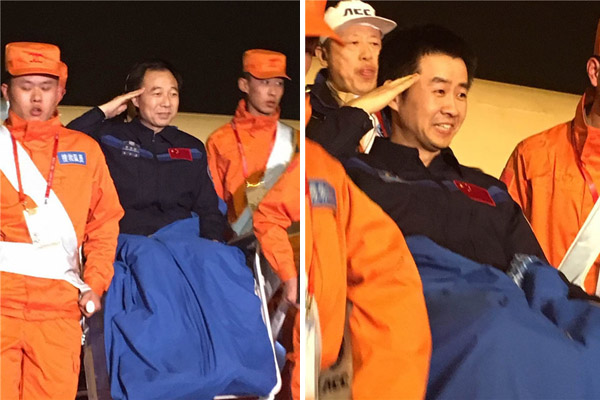Astrophysics and aesthetics
|
Chinese astronauts Jing Haipeng (L) and Chen Dong salute as they are carried off the plane that brought them to Beijing on Friday evening. The two had returned to Earth earlier the same day after a monthlong space mission.Yang Xin / Xinhua |
Black hole
The discovery of a special type of "violent-tempered" black hole in the Milky Way owes a huge debt to medical science, but it was Zhang who made thecross-disciplinary discovery.
He undertook post-doctoral research in the United States, and studied the process by which medical images are obtained.
Later, when he worked for NASA in 1992, he used medical imaging software to deal with astronomical observation data.
The move resulted in the creation of imaging technology to measure the earth's occultation - the movement of a celestial body across the line of sight of an observer and another object in space - which Zhang publicized in Nature, one of the world's most respected academic journals, in 1994.
The unconventional scientist used the technique to analyze data sent back by a gamma-ray astronomical satellite.
"Suddenly, one day I found a new gamma-ray celestial body, which was the brightest object in space at that time. I was astounded - I knew it was a big discovery," he recalled.
He had pinpointed only the second micro-quasar ever discovered in the Milky Way. It was a violent, jet-spouting black hole seven times the mass of the Sun.
Zhang and his colleagues devised a method to measure the rotation of black holes, which attracted great attention in academic circles, and he was lead author of an article on the phenomenon, published in the journal Science in 2000.
"The study of black holes constantly surprises me. It's challenging and very interesting," he said.
Although Zhang shared a group award from NASA for the discovery, he was barred from leading a satellite project because the US space administration doesn't allow Chinese scientists to lead key projects.
He left NASA, and in 2002 he accepted an invitation from his former tutor, Li Tipei, an academician at CAS, to help develop the HXMT telescope.
Research and development of the space telescope was a tortuous process that lasted more than a decade.
Zhang said he is under so much pressure from the imminent launch and has so many things to deal with that he has no time to feel excited. He also has severe back pain as a result of working long hours.
Meanwhile, the probe developed by Zhang's team on Tiangong II, which was launched in September, is working well in the search for gamma-ray bursts, the strongest explosions in the universe.
Zhang also wants to try something outside the original plan because he and his team have succeeded in locating signals from the Crab Pulsar, a young neutron star, by analyzing data sent back by the probe.
"This is the first time a Chinese-made astronomical instrument has been used to study the remaining pulsar left by a supernova explosion recorded by Chinese astronomers nearly 1,000 years ago," he said.



























